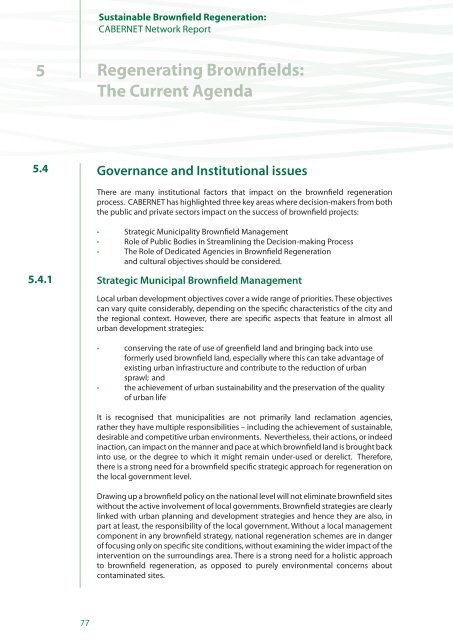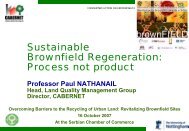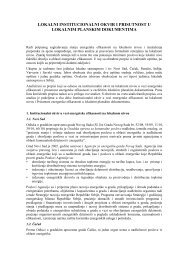Sustainable Brownfield Regeneration: CABERNET Network Report
Sustainable Brownfield Regeneration: CABERNET Network Report
Sustainable Brownfield Regeneration: CABERNET Network Report
Create successful ePaper yourself
Turn your PDF publications into a flip-book with our unique Google optimized e-Paper software.
<strong>Sustainable</strong> <strong>Brownfield</strong> <strong>Regeneration</strong>:<strong>CABERNET</strong> <strong>Network</strong> <strong>Report</strong>5Regenerating <strong>Brownfield</strong>s:The Current Agenda5.4 Governance and Institutional issuesThere are many institutional factors that impact on the brownfield regenerationprocess. <strong>CABERNET</strong> has highlighted three key areas where decision-makers from boththe public and private sectors impact on the success of brownfield projects:5.4.1• Strategic Municipality <strong>Brownfield</strong> Management• Role of Public Bodies in Streamlining the Decision-making Process• The Role of Dedicated Agencies in <strong>Brownfield</strong> <strong>Regeneration</strong>and cultural objectives should be considered.Strategic Municipal <strong>Brownfield</strong> ManagementLocal urban development objectives cover a wide range of priorities. These objectivescan vary quite considerably, depending on the specific characteristics of the city andthe regional context. However, there are specific aspects that feature in almost allurban development strategies:• conserving the rate of use of greenfield land and bringing back into useformerly used brownfield land, especially where this can take advantage ofexisting urban infrastructure and contribute to the reduction of urbansprawl; and• the achievement of urban sustainability and the preservation of the qualityof urban lifeIt is recognised that municipalities are not primarily land reclamation agencies,rather they have multiple responsibilities – including the achievement of sustainable,desirable and competitive urban environments. Nevertheless, their actions, or indeedinaction, can impact on the manner and pace at which brownfield land is brought backinto use, or the degree to which it might remain under-used or derelict. Therefore,there is a strong need for a brownfield specific strategic approach for regeneration onthe local government level.Drawing up a brownfield policy on the national level will not eliminate brownfield siteswithout the active involvement of local governments. <strong>Brownfield</strong> strategies are clearlylinked with urban planning and development strategies and hence they are also, inpart at least, the responsibility of the local government. Without a local managementcomponent in any brownfield strategy, national regeneration schemes are in dangerof focusing only on specific site conditions, without examining the wider impact of theintervention on the surroundings area. There is a strong need for a holistic approachto brownfield regeneration, as opposed to purely environmental concerns aboutcontaminated sites.77
















